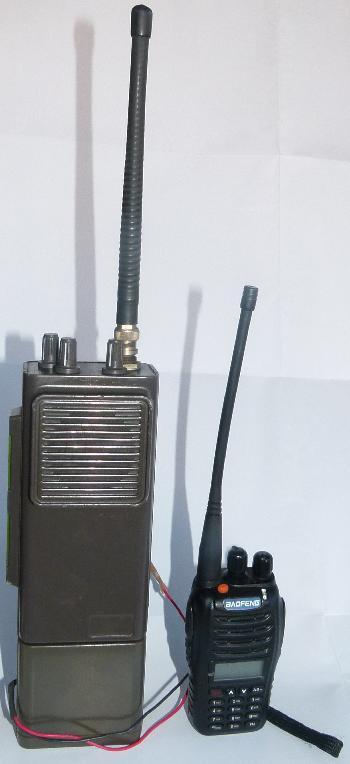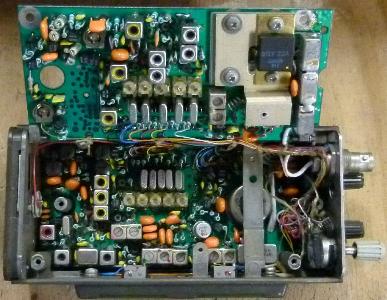<- Back root
Philips SXA UHF Handheld

|
The
Philips SXA
is a rather large, extremely robust handheld transceiver that can also do double duty as
a hammer, a wheel chock for a truck, or an anchor for a small boat.
Designed in 1979, it features five crystal-controlled channels, and models were available for
low VHF, high VHF and UHF, with power ratings of 1W, 2W or 5W. My UHF model puts out 2W, and
has crystals for 434.200, 434.300, 434.500, 434.600 and 434.625. The last two are set up as
repeater channels
transmitting at 1.6
MHz below the receive frequency.

They're beautifully made, with the receiver and transmitter on separate PCBs which are both
hinged to provide access. And as mentioned, you can drive a truck over one and it will still
work.
As you can see, the previous owner removed the (presumably stuffed) batteries and brought out
wires to power the rig from an external source. The battery pack is just ten "AA"
NiCad cells, so rebuilding it is no great effort, and this one already has crystals for
amateur frequencies so with a little work I can have a really large UHF transceiver.
In contrast, the
Baofeng UV-B5 next to it covers
both 2m and 70cm, puts out 5W, has 99 channels, dual VFOs, subtone (CTCSS) to key the repeater, DTMF,
a scanner and an FM radio.
And there endeth today's lesson in how far we've come in 35 years.
|
Technical: UHF model
I have a second SXA, missing half the mechanicals. I'm toying with converting it to APRS.
Tx is crystallised for 433.025, 432.000, 453.475, 453.425 and 453.525. Yea, that's a bit
wild. The last three cystals are also marked 56.684375, 56.678125 and 56.690625 so
Tx freq = Tx xtal x 8
Same as the VHF models.
To get the Tx board working in standalone mode, you need 12V on the red (PA supply) and white
wires with ground on blue. Ground one of the five (blue, yellow, red, grey and white) wires
connected to the crystals. The black wire isn't connected to anything on my board, and green
is the modulation signal. Easy.
The receiver crystals are for 434.625, 432.000, 453.475, 453.425 and 453.525. Again, the last
three crystals have the actual frequency on them, 54.009375, 54.003125 and 54.015625.
Rx freq = Rx xtal * 8 + 21.4
The receive IF is at 21.4 MHz, using a
Tonron MCF21M15D 8-pole 15 kHz wide
crystal filter.
Getting the Rx board working in standalone mode is equally simple, as long as you realise that
the pot with the switch on it is the squelch not the volume control. I recommend leaving the
receive board in the aliminium chassis, it seems to need the shielding. Ground a wire to select
a crystal, connect 12V to the red and blue wires, and you should be GTG.
Audio amplifier is a
Philips TBA915.
A BGY22A
420 - 480 MHz
RF
amplifier module is used to provide 2.5W output. It's designed for FM only -- there goes
my idea of hacking this thing to do SSB.
You can get the
Service
Manual for the VHF versions off of Google Drive. It's in Dutch but that
doesn't
bother me. Also, schematics are kind of a universal language.
Here's
a nice review but it's also in Dutch... (from ftp://54685ff3.cm-12-1b.dynamic.ziggo.nl/elektuur/1998/articles/2007/N0712103.pdf)
|
![[Image] Hit Count](/cgi-bin/Count.cgi?df=wrm-zs1ke-SXA.dat) hits since 2015-03-09.
hits since 2015-03-09.
|
Back
|
(This page last modified
2020-01-06)
|

